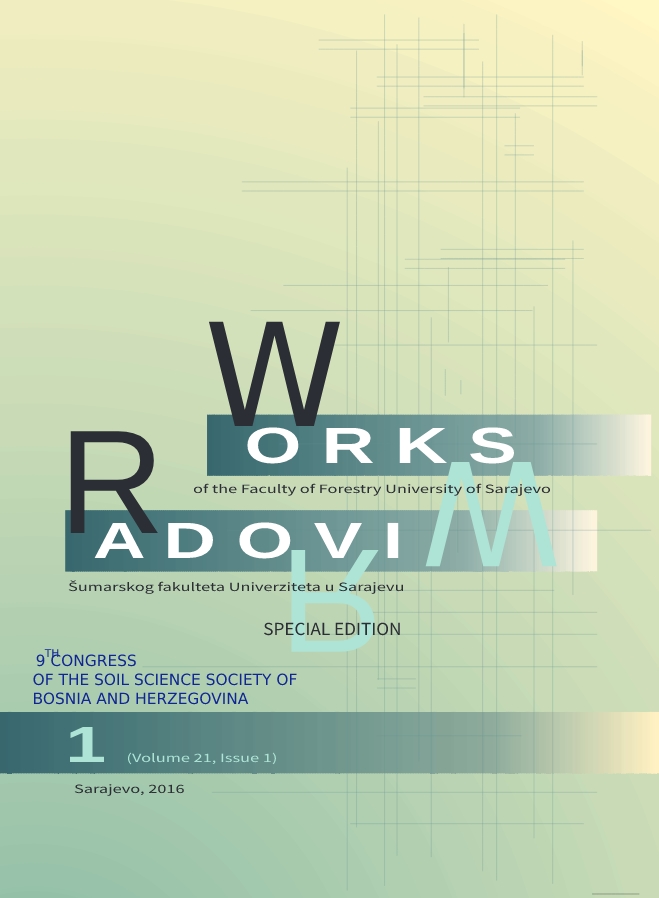MOBILITY OF IMAZETHAPYR DEPENDING ON THE CHARACTERISTICS OF SOIL
DOI:
https://doi.org/10.54652/rsf.2016.v1.i1.307Ključne riječi:
herbicide, imazethapyr, soil, mobility, pH soilSažetak
UDK 631.41:632.954(497.6)
The aim of the study was to research the mobility of imazethapyr in three types of soil in the disturbed conditions (laboratory labels KDIL, PILKD and PILKE), whose pH in H2O varied from 4.55 to 7.01 using the methods of biological testing. In the study it was used PIVOT-M which contains 100 gl-1 of imazethapyr as ammonium salt and is formulated as the concentrated solution (SL).
Imazethapyr was washed out through the PVC columns, with the inner diameter of 45 mm and 20 cm long (4x5 cm). The amount of water used for eluting of the deposit amount of the herbicide suited the amount of 50, 100 and 200 l of water/m2 and deposite amount of herbicide was 1.0 lha-1. After the washout and draining of the column, the soil column was extruded and divided into the segments of 5cm. On the soil extract of 5 cm, 10 g of dry and noncontaminated soil of the same type was added to drain the extract and prepare for planting. Soil sample of 110 g of soil (110 g of the soil from the column + 10 g of the “pure“ soil) is placed into the pot with the diameter of 5 cm and 8 seeds of oats were planted. Such formed pots are placed into the greenhouse in order to measure biometric indicators after 21 day (fresh mass of the shoot and root, dry mass of the shoot and root).
The mobility of imazethapyr depends on the chemical characteristics and mechanical content of the soil. In this study, placing in the regressive dependence of the soil characteristics [humus content (%), clay (%) and sand (%)], as an independent variable, with the amount of water required for elution, as dependent size, they could not demonstrate dependency relationships observed through a linear regression. However, when you observe pH dependence of soil and water volume (CV) required for elution of imazethapyr from the first 5 cm through the exponential regression of the first line, so that inhibition of oats growth, which is grown in the soil from that part of the column, was 10%, and which corresponds values of NOEL, it can be drawn a conclusion thatfunctional dependency is established statistically significant, with a coefficient of determination 0.987. It tells us that the mobility of imazethapyr in the soil is greater as the pH of the soil is greater, which means that imazethapyr is very mobile in the neutral or soils with the weak basis.
Downloads
References
Ahmad, R., Kookana, S. R., Alston, M. A. 2001. Sorption of ametryn and imazethapyrin twenty-five soils from Pakistanand Australia. Journal of Environmental Science and Health Part B 36(2), 143–160.
Gan, J., Weimer, M. R., Koskinen, W. C., Buhler, D. D., Wyse, D. L., Becker, R. L. 1994. Sorption and desorption of imazethapyr and 5-hydroxyimazethapyr in Minnesota soils. Weed Sci. 42, 92–97.
Gennari, M., Nègre M., Vindrola, D. 1998. Adsorption of the herbicides imazapyr, imazethapyr, and imazaquin on soils and humic acids. J. Environ. Sci. Heal. B. 33, 547-567.
Goetz, J. A., Wehtje, G., Walker, R. H., Hajek, B. 1986. Soil solution and mobylity characterization of imazaquin. Weed Sci. 34, 788-793.
Janjić, V., Marisavljević, Dragana, Popović, Lj., Bogdanović, V. 1992. Mogućnost korišćenja ovsa (Avena sativa L.) za praćenje sadržaja i dinamike ispiranja atrazina u zemljištu. Acta herbologica, 1, 2, 221-229.
Johnson, H. D., Shaner Dale, L. D., James, D., Mackersie, A.L., Tuxhorn, G. 2000. Time- dependent adsorption of imazethapyr to soil. Weed Science, 48, 769–775.
Kah, Melanie. 2007. Behaviour of ionisable pesticides in soil. PhD Thesis. University of York, Environment Department.
Loux, M. M., Liebl, A. R., Slife, W. F. 1989. Adsotption of Imazaquin on Soil, Sediments, and Selected Adsordents. Weed Science, 37, 712-718.
Loux, M. M., Reese, K. D. 1992. Effect of soil-pH on adsorption and persistence of imazaquin. Weed Sci. 40, 490-496.
Nègre, M., Schulten H.R., Gennari, M., Vindrola, D. 2001. Interaction of imidazolinone herbicides with soil humic acids. Experimental results and molecular modeling. J. Environ. Sci. Health, B36(2), 107–125.
Oliveira Jr., R. S., Koskinen, W. C., Ferreira, F. A. 2001. Sorption and leaching potential of herbicides on Brazilian soils. Weed Research, 41, 97-110.
Renner, K. A., Meggitt, W. F., Penner, D. 1988. Effect of Soil pH on Imazaquim and Imazethapir Adsorption to Soil and Phytotoxicity to Corn (Zea mays). Weed Science, 36, 78-83.
Sakaliene, Ona, Papiernik, K. S., Koskinen, C. W., Spokas, A. K. 2007. Sorption and predicted mobility of herbicides in Baltic soils. Journal of Enviromental Science and Health Part B, 42, 641-647.
Stougaard, R. N., Shea, P. J., Martin, A. R. 1990. Effect of Soil Type and pH on Adsorption, Mobility, and Efficacy of Imazaquin and Imazethapyr. Weed Science, 38, 1, 67-73.
Vischetti, C., Trevisan, M., Esposito, A., Scarponi, L. 2002. Ability of three pesticide leaching models to simulate summer crops in a Mediterranean scenario. Agronomie, 22, 351-361.
Woondimagegnehu, Marsie, Chester L. Foy. 1986. Adsorption, Desorption, and Mobility of Clorsulfuron in Soils. J. Agric. Food Chem., 34, 89-92.























